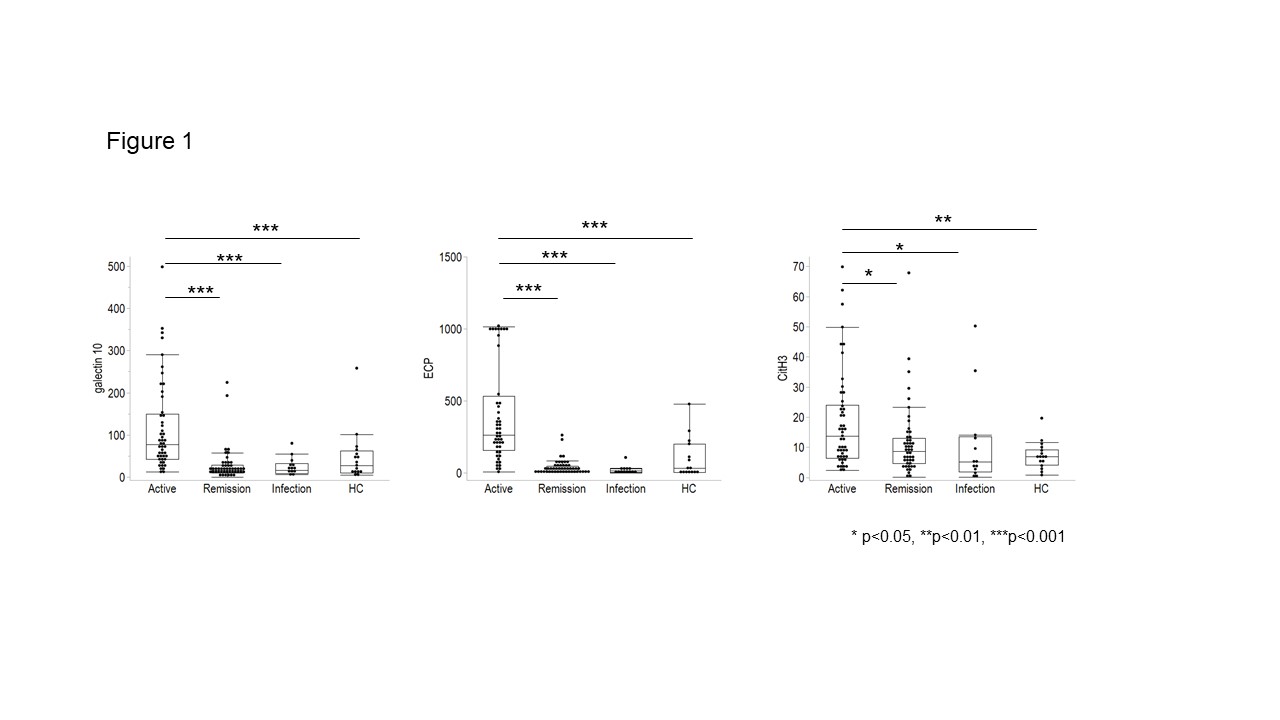Session Information
Date: Tuesday, November 14, 2023
Title: (2370–2386) Vasculitis – ANCA-Associated Poster III: Biomarkers & Renal Outcomes
Session Type: Poster Session C
Session Time: 9:00AM-11:00AM
Background/Purpose: Antineutrophil cytoplasmic antibody (ANCA)-associated vasculitis (AAV) is a life-threatening disease requiring complex management due to a lack of suitable biomarkers. Elevated or persistently positive ANCA titer as an indicator of disease activity or relapse in patients with AAV remains controversial. ANCA can activate eosinophils to induce cell death, which in turn releases histone-coated filamentous DNA, referred to as eosinophil extracellular traps (EETs). Eosinophils play an important role in eosinophilic granulomatosis with polyangiitis, and galectin-10, which is released from EETs, is useful as a biomarker. However, the role of eosinophils in granulomatosis with polyangiitis (GPA) and microscopic polyangiitis (MPA) remains unclear. Therefore, we investigated the association of galectin 10, eosinophil cationic protein (ECP), and citrullinated histone H3 (CitH3), which is a marker of EETs and neutrophil extracellular traps, with disease activity in GPA and MPA using Birmingham Vasculitis Activity Score (BVAS).
Methods: Serum concentrations of galectin-10, ECP, and CitH3 were retrospectively examined in 50 patients with AAV both in active and remission states, 13 patients with AAV in remission states with infection, and 16 age- and sex-matched healthy controls using ELISA kits. Additionally, the association between disease activity and conventional markers such as ANCA and CRP was also evaluated.
Results: The serum concentrations of galectin-10, ECP, and CitH3 in active AAV were significantly higher than those in remission AAV, remission with infection AAV, and HC groups (Figure 1). BVAS was associated with galectin-10 and ECP (r=0.62, p< 0.001 and r=0.69, p< 0.001, respectively), but only weakly associated with CitH3 (r=0.21, p< 0.05). ANCA titer was associated with the BVAS score (r=0.71, p< 0.001). Elevated serum galectin-10, ECP, and ANCA titers were identified as factors associated with the active phase using multivariate analysis with eosinophil count as a covariate. Receiver operating characteristic analyses for galectin-10, ECP, and ANCA titers for discriminating between active disease and remission revealed an area under the curve (AUC) of 0.886, with a sensitivity of 81.3% and specificity of 85%, AUC of 0.938, with a sensitivity of 83.3% and specificity of 95.1%, and AUC of 0.888, with a sensitivity of 69.4% and specificity of 93.5%, respectively.
Conclusion: Galectin-10 and ECP levels are elevated in patients with GPA and MPA, and can discriminate between active disease and remission independent of eosinophil counts. This suggests that the activation of both neutrophils and eosinophils is important for disease activity.
To cite this abstract in AMA style:
Hashimoto T, Noguchi K, Minagawa Y, Abe T, Tamura M, Furukawa T, Azuma N, Matsui K. Eosinophil Activation as a Biomarker for Discriminating Active and Remission Phase in ANCA-Associated Vasculitis [abstract]. Arthritis Rheumatol. 2023; 75 (suppl 9). https://acrabstracts.org/abstract/eosinophil-activation-as-a-biomarker-for-discriminating-active-and-remission-phase-in-anca-associated-vasculitis/. Accessed .« Back to ACR Convergence 2023
ACR Meeting Abstracts - https://acrabstracts.org/abstract/eosinophil-activation-as-a-biomarker-for-discriminating-active-and-remission-phase-in-anca-associated-vasculitis/

